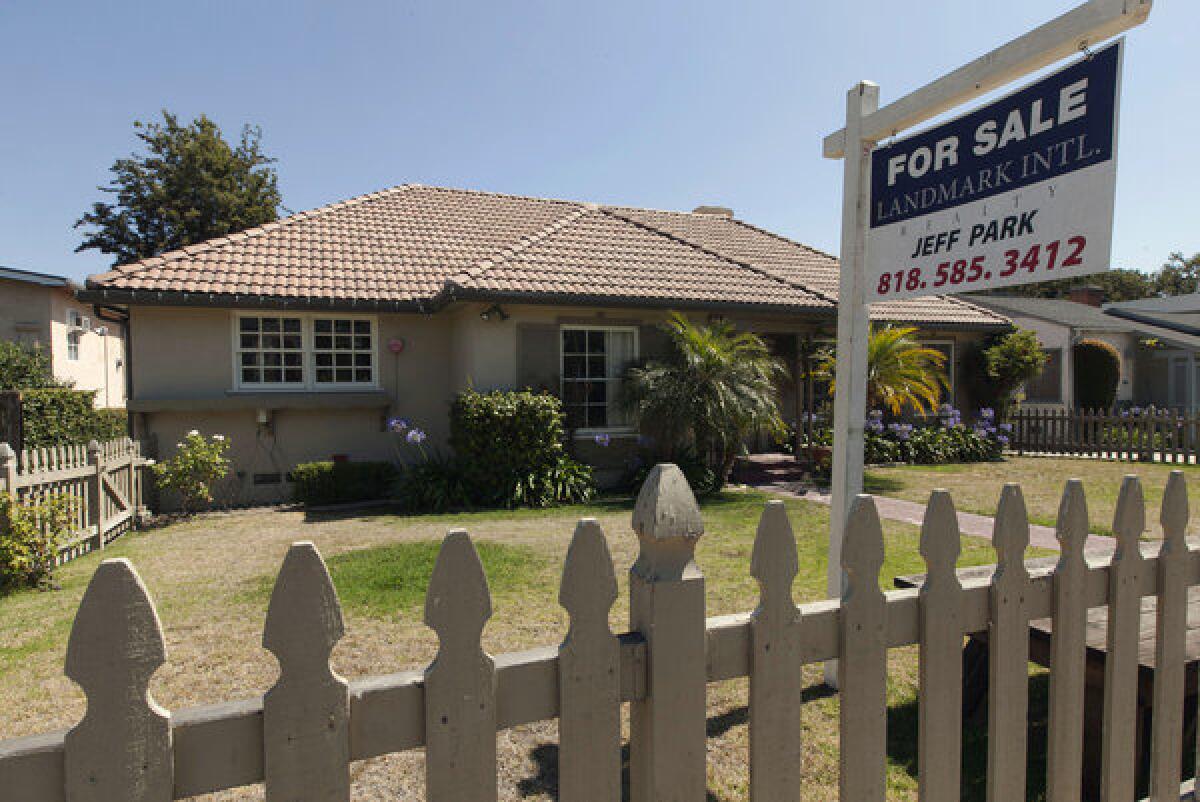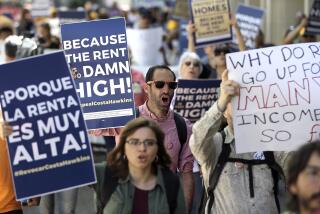California has a housing crisis. A bill would allow a duplex on most single-family parcels

- Share via
The California Assembly is considering a bill that would require local governments to permit duplexes on parcels now largely restricted to one house, in effect eliminating single-family zoning that dominates in most suburban residential neighborhoods.
The measure, Senate Bill 1120, is pitched as a way to ease a long-running housing shortage that has hammered low- and middle-class families throughout California but is drawing criticism from homeowners concerned it will fundamentally change their neighborhoods.
If ultimately passed by the Legislature and signed into law by Gov. Gavin Newsom, the bill wouldn’t outlaw single-family houses. Instead, property owners could convert their single-family house into a duplex or demolish the house and in its place build two new single-family homes or a duplex.
Property owners could also split a single-family lot into two and then build two additional units, thus placing four homes where there previously was one.
“SB 1120,” said David Garcia, policy director for the Terner Center for Housing Innovation at UC Berkeley, “has the potential to make meaningful progress on our housing challenges.”
The bill isn’t sure to pass and a number of housing bills have failed this year as legislators grapple with the coronavirus. But in many ways California’s housing crisis has only grown worse as millions of people have been thrown out of work.
Economists generally agree the root cause of the state’s exorbitant rents and home prices is that for decades too few homes have been built to satisfy demand, creating a shortage that’s forced people to bid up the cost of housing to find a place to live.
Some haven’t found a place at all and decided to leave the state. In the worst cases, people have ended up in tents and RVs that line the streets.
In addition to expanding supply, which in theory would reduce pressure on housing costs, Garcia said SB 1120 could directly bring more moderately priced housing into neighborhoods, particularly affluent communities that make it difficult to add housing through zoning and other regulations.
The cost of constructing single-family homes and duplexes tends to be lower than stacking many units on top of one another in apartment buildings, he said, creating the potential for new rentals out of SB 1120 that would be cheaper than nearby, recently built apartment complexes.
Because the bill would allow a lot split, property owners could also build another single-family house or duplex — then sell it.
Given the space available to build, Garcia said those new homes are likely to be smaller than the existing home, as well as others in the neighborhood.
“Ideally the smaller, for sale homes will be less expensive,” he said.
Most Read
The bill’s author, state Senate President Pro Tem Toni Atkins (D-San Diego), called it a way to increase density and produce “naturally affordable housing options” without public subsidies, while “keeping the character of neighborhoods intact.”
“Put simply, this bill merely permits small-scale additional density without building up or out in neighborhoods,” she said in a statement.
According to Richard Rothstein’s “The Color of Law: A Forgotten History of How Our Government Segregated America,” single-family zoning proliferated across the country, in part because of a desire to keep people of color out of white neighborhoods after the U.S. Supreme Court outlawed zoning by race in the early 1900s.
Given the country’s racial wealth gap, critics say single-family zoning still serves as a barrier for people of color to live in certain neighborhoods.
As he’s sagged in the polls, President Trump and his supporters have increasingly tied, without evidence, the ending of single-family zoning to an increase in crime by using language that has a long history in the U.S. of being used as a racist dog whistle to appeal to white suburban voters.
“This forced rezoning would bring crime, lawlessness and low-quality apartments into now thriving suburban neighborhoods,” Patricia McCloskey said Monday at the Republican National Convention, one month after she and her husband were charged with unlawful use of a weapon for waving guns at people outside their house who were protesting racial injustice in the wake of George Floyd’s killing.
Academic research has shown little to no link between subsidized housing and higher crime rates.
Today, single-family neighborhoods in places such as South Los Angeles are mostly home to Black and Latino households, and residents there also want to preserve the single-family character.
Many community groups see SB 1120 as a giveaway to the real estate industry that will obliterate an American ideal, the single-family house, while not helping low-income families hit hardest by the affordability crisis and coronavirus.
The bill doesn’t mandate below market units, and there are concerns it would accelerate gentrification in some Black and Latino communities such as South L.A., where home prices and rents in recent years have risen faster than the region as a whole as wealthier, often white people move in.
John Gonzales, a Baldwin Hills resident and real estate broker involved in local planning issues, said developers are likely to swarm South L.A. and, knowing they can build more units, will pay more for a house than a typical buyer, making it even harder for local families to buy.
Although the new homes may be less expensive, he doubts they will be drastically cheaper and worries the smaller units will be less attractive to some Latino and Black families in the community.
“The local community tends to be multigenerational,” Gonzales said.
Property owners would be prohibited from using SB 1120 if a property has been occupied by a tenant in at least the previous three years, but community groups are concerned such prohibitions aren’t long enough and may be tough to enforce.
Diane Robertson, a Leimert Park resident who, like Gonzales, is a member of South LA Alliance for Locally Planned Growth, said the inclusion of below-market housing would make the bill “less egregious” but there would still be too many problems.
As multiple units replace one, she said, neighborhoods would grow noisier, have less parking and have more renters she sees as less invested in the neighborhood.
“There are many people, in my community here in South Los Angeles, who saved money, desired to be in a nice, single-family neighborhood and purchased their home on that basis,” Robertson said. “Now our legislators are telling us, ‘Well it doesn’t matter what you want.’”
The issue of single-family housing has been hotly debated in recent years across the country, as affordable housing has become a more pressing matter. Minneapolis and Oregon passed laws that end, or nearly end single-family zoning.
Single-family zoning in California has been eroded in recent years by laws governing so-called accessory dwelling units, or ADUs. The new laws have allowed most owners of a single-family house to build a backyard home of at least 800 square feet and convert a portion of their house to a third unit, as long as it wasn’t larger than 500 square feet.
Those units, often called granny flats, are frequently the cheapest new units on the market, according to Zillow advertisements. A 2017 Terner Center study of accessory dwelling units in Seattle, Portland, Ore., and Vancouver, Wash., found the majority of homeowners actually rented their backyard units for less than market rate.
Garcia attributed the lower rent to both relatively low construction costs for the units, as well as the fact construction is frequently undertaken by individual homeowners who probably have less of a profit motive than a traditional developer — something he hopes can be replicated with SB 1120.
The bill would be different from current ADU law in several ways.
Accessory units can’t be sold, except in rare instances. And SB 1120 opens up the possibility of larger homes than ADU laws currently allow, as well as four units where one now stands, rather than three.
Some critics worry property owners could double-dip between ADUs and SB 1120 to put more than four homes on a lot. But according to a legislative staffer, that’s not allowed unless a city allows it.
SB 1120 wouldn’t apply in rural areas and historic districts.
Cities could also apply design standards to new units “unless those standards would have the effect of physically precluding the construction of up to two units,” according to the bill’s current language.
A Terner Center analysis said those design requirements, along with some rules surrounding the size of lots that are split, could reduce the number of homes actually built.
But if owners of just 5% of eligible properties decided to split their lot and build two additional units, it would create nearly 600,000 new homes, according to a Terner Center analysis.
The bill, which was proposed as a more modest step at increasing density than the failed Senate Bill 50, isn’t certain to become law.
Although its author, Atkins, is one of the most powerful leaders in Sacramento, which usually gives bills a leg up, SB 1120 passed out of its last committee in the Assembly with three Democratic abstentions, a sign of potential weakness.
If the bill passes the Assembly it must go back to the Senate because it’s been amended slightly, but must pass both houses by Aug 31. If it does, SB 1120 would then need to be signed into law by Newsom.
If the bill fails, it would be the latest defeat this year for a series of housing production proposals despite promises from both Atkins and Newsom to pass a measure to increase the supply of housing after SB 50 failed in January.
In a news conference last week, Newsom said the COVID-19 pandemic has made it more difficult to pass legislation, but that “we are committed to fast-tracking the development of housing in the state of California.”
Times staff writer Liam Dillon contributed to this report.
More to Read
Sign up for Essential California
The most important California stories and recommendations in your inbox every morning.
You may occasionally receive promotional content from the Los Angeles Times.






